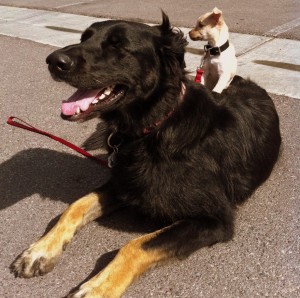“Shock” Collar Training – The Elephant in the Room
We use remote training collars (some people refer to them as Shock collars). There, I said it. I have now officially outed us…
 We also use clickers and other assorted training markers, treats, toys, leashes, head collars, and prong collars. We’ve even been known to use a bark collar once or twice. We teach our dogs to tug and play. We teach them to make choices. We teach them that there are consequences to those choices. We show them the value in making the right choice. We also teach them how to make mistakes and to recover from those mistakes so that they can try again to make the right choice. We train using operant conditioning (mostly) and a positive reinforcement mindset. We want learning to be fun for my dogs but we also expect them to be obedient.
We also use clickers and other assorted training markers, treats, toys, leashes, head collars, and prong collars. We’ve even been known to use a bark collar once or twice. We teach our dogs to tug and play. We teach them to make choices. We teach them that there are consequences to those choices. We show them the value in making the right choice. We also teach them how to make mistakes and to recover from those mistakes so that they can try again to make the right choice. We train using operant conditioning (mostly) and a positive reinforcement mindset. We want learning to be fun for my dogs but we also expect them to be obedient.
So what does this say about us as trainers? Well, some folks would have you believe that because we use training aids that are considered controversial, such as remote training collars and prong collars, that we must be bad trainers and that, by extension, we must also treat our dogs poorly. But here’s the thing…
 I love my clicker – which in my case is a marker word “YES!”. We love shaping behaviors with our dogs. It’s fun and sometimes, it’s entertainingly unpredictable. In the right hands, a clicker or marker training is a great communication tool. But, surprise, surprise, as a trainer, we don’t recommend it for everyone. Clicker training requires good mechanics and even better timing. It requires developing a certain amount of proficiency with the clicker in order to achieve solid results. It requires an understanding of rates of reward; how and when to begin to associate verbal cues and of course; how and when to fade out the clicker and food (or toy) and still maintain a good degree of reliability for the behavior being taught. Who to break down a desired behavior into shapable steps and when to progress to the next step.
I love my clicker – which in my case is a marker word “YES!”. We love shaping behaviors with our dogs. It’s fun and sometimes, it’s entertainingly unpredictable. In the right hands, a clicker or marker training is a great communication tool. But, surprise, surprise, as a trainer, we don’t recommend it for everyone. Clicker training requires good mechanics and even better timing. It requires developing a certain amount of proficiency with the clicker in order to achieve solid results. It requires an understanding of rates of reward; how and when to begin to associate verbal cues and of course; how and when to fade out the clicker and food (or toy) and still maintain a good degree of reliability for the behavior being taught. Who to break down a desired behavior into shapable steps and when to progress to the next step.
Now, I’m sure that we will get some negative feedback from clicker-only trainers out there for what I’m about to say, and that’s okay. Everyone is entitled to their point of view and we respect that ours may not be the same…
 We have a client (several) who’s dog HATES clicker training, HATES shaping and gets incredibly stressed when we or his owner try to use this method of training with her. She demonstrates the typical stress behaviors during clicker training sessions that so many believe are not supposed to be present in the dog during clicker training. But no matter how hard we try, how much we reinforce, how much we break down the behavior we are trying to teach, this dog just doesn’t GET it. What??? A dog that doesn’t understand clicker training? It doesn’t exist, right? I’m here to tell you that it does. More then just a couple. Some folks would tell you that the fault is mine and that we must be doing something wrong. We are happy to demonstrate my mechanics and my skills with a clicker to anyone who’d like to see them. I’ll let you tell us what you think.
We have a client (several) who’s dog HATES clicker training, HATES shaping and gets incredibly stressed when we or his owner try to use this method of training with her. She demonstrates the typical stress behaviors during clicker training sessions that so many believe are not supposed to be present in the dog during clicker training. But no matter how hard we try, how much we reinforce, how much we break down the behavior we are trying to teach, this dog just doesn’t GET it. What??? A dog that doesn’t understand clicker training? It doesn’t exist, right? I’m here to tell you that it does. More then just a couple. Some folks would tell you that the fault is mine and that we must be doing something wrong. We are happy to demonstrate my mechanics and my skills with a clicker to anyone who’d like to see them. I’ll let you tell us what you think.
Additionally, we get many dogs into our system that were told by one or more clicker trainers their dog cannot be trained! Or must be put down because their narrow focus of training tools cannot help them. But, back to this dog… This girl learns best when lured into behaviors, when shown through physical pressure (such as my hand pressing down on her bum to encourage a sit), and through lots and lots of repetition. I know that she’s not the only dog out there like this. So is the clicker the right training method for this dog? Probably not. To her, the clicker is an aversive. She learns best using a traditional approach paired with lots of positive reinforcement in order to teach her what is the desired outcome. Over and over and over again.
 Not all dogs, and not all dog owners, are created equal. That’s just plain fact and I’m not ashamed to say it. Just like people have different learning styles or affinities, so do dogs. To our way of thinking, this also means that not all training aids are suitable for a given dog/owner team. Our job, as professional dog trainers, is to be educated about all available training aids, to evaluate you, your dog, and your goals, and then to help YOU make an informed decision about how to train your dog and what training aids and methods are appropriate for you and your dog. Plain and simple. We’ll even be honest enough to tell you if we don’t think we are the right fit for you and your dog.
Not all dogs, and not all dog owners, are created equal. That’s just plain fact and I’m not ashamed to say it. Just like people have different learning styles or affinities, so do dogs. To our way of thinking, this also means that not all training aids are suitable for a given dog/owner team. Our job, as professional dog trainers, is to be educated about all available training aids, to evaluate you, your dog, and your goals, and then to help YOU make an informed decision about how to train your dog and what training aids and methods are appropriate for you and your dog. Plain and simple. We’ll even be honest enough to tell you if we don’t think we are the right fit for you and your dog.
 A GOOD trainer should be able to speak from experience and not from rhetoric. A GOOD trainer will understand the science behind the various training aids and methods out there, both positive and negative. A GOOD trainer will be able to demonstrate proper use of those aids and methods with their dog and with yours. And a GOOD trainer will always be open to learning and listening. Some of the great people in the dog training world that have influenced us in my development as a dog trainer are renowned positive reinforcement protection sports trainer Michael Ellis, creator of “Control Unleashed” Leslie McDevitt, world class agility competitors and trainers Susan Garrett and Silvia Trkman, just to name a few. Every day, we learn something new when it comes to dogs and dog training. It’s a journey that we hope never ends.
A GOOD trainer should be able to speak from experience and not from rhetoric. A GOOD trainer will understand the science behind the various training aids and methods out there, both positive and negative. A GOOD trainer will be able to demonstrate proper use of those aids and methods with their dog and with yours. And a GOOD trainer will always be open to learning and listening. Some of the great people in the dog training world that have influenced us in my development as a dog trainer are renowned positive reinforcement protection sports trainer Michael Ellis, creator of “Control Unleashed” Leslie McDevitt, world class agility competitors and trainers Susan Garrett and Silvia Trkman, just to name a few. Every day, we learn something new when it comes to dogs and dog training. It’s a journey that we hope never ends.
So yes, we use remote training collars. We are and always will be, at the core, a positive reinforcement trainer. But we are not a “pure positive” trainer. Trainers like us refer to ourselves as Balanced Trainers.
If you’d like to know the hows and the whys of what we do as trainers, let’s set up a time to meet and we can have a good open conversation about any and all training aids as well as the science. We’ll show you what we can do. You’ll meet one (or two) of my dogs or my other trainer’s dog(s) – a product of our training philosophy and skill set – and be able to see for yourself what we do as a trainers. We might, if we both keep an open mind, learn something from each other. Heck, I’ll even bring a remote collar, strap it on myself and let you work the remote.
Here is a link to videos of dogs we have trained and we are using ecollars on in most cases (bet you can’t tell). See for yourself happy confident dogs.
You can be the judge.
